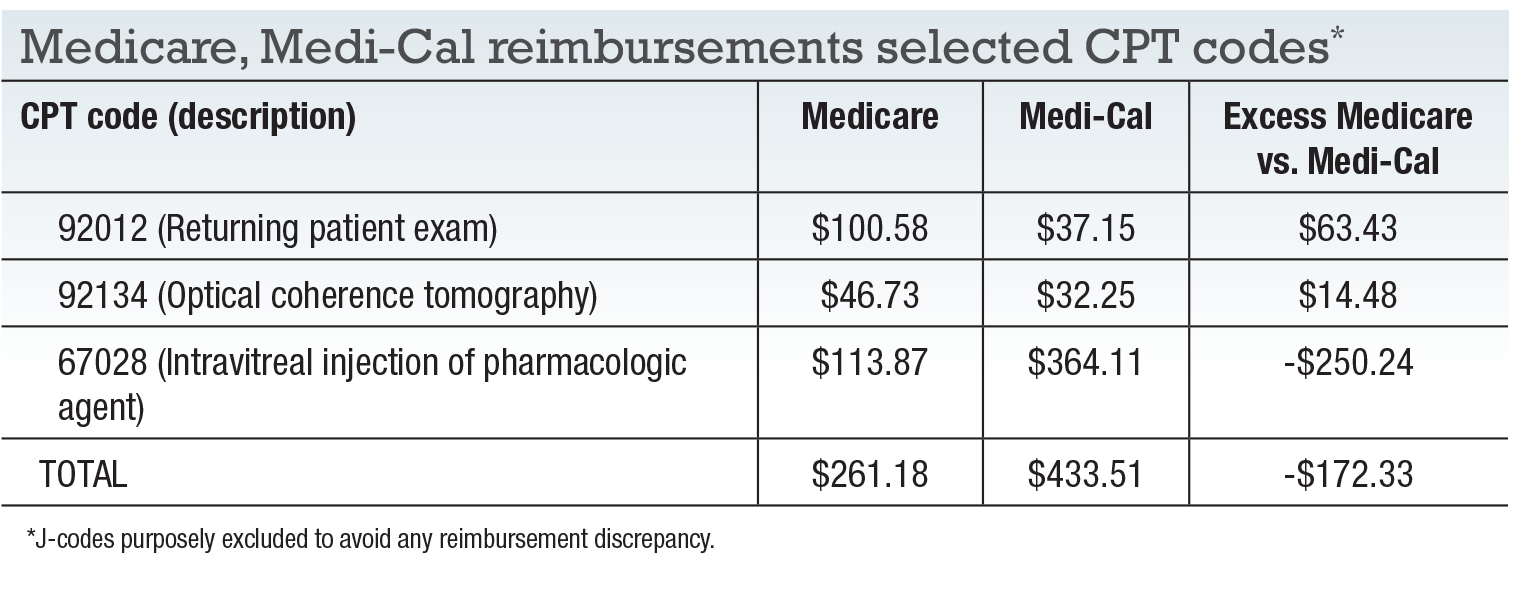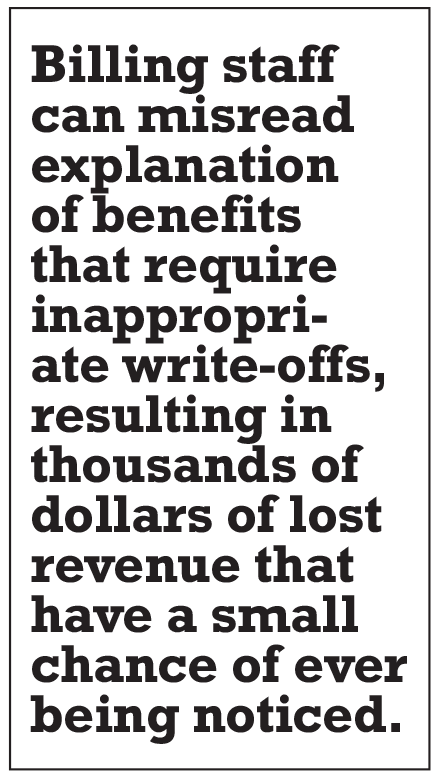 |
 |
Like “uphill battle” or “slippery slope,” “negotiating payer contracts” is a phrase that you don’t often connect with success and satisfaction. Negotiating with payers is challenging, defeating, frustrating and promising all at the same time. Yet, just as battles can be won and hills can be overcome, contracts can be successfully negotiated.
To provide insight into how involved physicians are in the contract and billing aspects of their practices, 50 retina specialists recently participated in a short survey. They were asked to answer various contract and reimbursement questions with the same level of certainty used in medical decision-making. An overwhelming percentage couldn’t identify their best or worst contract, state what the reimbursement amount for a miscellaneous J-code would be, or indicate what contracts allowed more or less than Medicare rates. There is nothing wrong with a physician not knowing these answers, but it is absolutely necessarily that someone, preferably several staff members, does know them.
How much do you need or want it?
Just as we negotiate many things in daily life, such as the purchase of cars, homes and pharmaceuticals, we can negotiate payer contracts. In order to have a positive outcome to a negotiation, it is first important to evaluate three aspects:
• How much do you need a contract? In this situation, success will be measured by simply obtaining the contract, even if it’s not the most desirable fee schedule. Perhaps a new office is empty most of the time with staff and physicians idle, and this contract will boost patient appointments and generate some, although not optimal, revenue.
• How much do you need this contract? Obtaining a certain contract may be vital to eliminating a threat of another physician coming into your geographic area. Often, practices will accept some contracts at sub-par rates to preserve the patient population of other existing agreements.
• How much do you want this contract? Will obtaining this contract allow you to enter a new market area and open a new facility? Perhaps it will allow your practice to begin operating at a new desirable ambulatory surgery center, or it may even allow you to hire an additional associate and expand your group.
The WHAT of evaluating contracts
Consider the WHAT acronym to properly evaluate new or existing contracts. It covers four main areas:
• Who. To whom is the contract offered, individuals or groups?
• Hospitals. What hospitals and ASCs are in the network? Do they align with your current block time allocations?
• Attachments. What are the exhibits—fee schedule, carve outs, J-code exceptions and authorization requirements?
• Term/termination. What is the initial term? What are options for renewal? What are the clauses for termination with and without cause?
Know your region and competitors
In my career, I have seen many consulting companies enter practices and guarantee their ability to negotiate better rates or criticize already accepted rates. Although there’s always room for improvement, pushing too far in negotiating with some payers will result in the loss of the agreement.
Most commonly, when payers begin to explore opportunities with other practices, your competitors may accept the contract at your current or even lower rates. For example, in my current location, we are surrounded by retina specialists, even having two other competitors in our same building.
Before you negotiate, it’s vital to know how much revenue each contract generates and what percentage of the practice is dependent upon that payer. The results of this reporting structure will serve as a guide in determining how aggressive your negotiation strategy should be.
 |
Evaluating the fee schedule
Often anything associated with Medicaid or a contract based on a percentage of Medicaid is immediately deemed to be a sub-par return on investment of clinic time. However, now in an environment where injections are so common, a further evaluation of rates is necessary. For example, in California, Medi-Cal reimburses at the rates noted in the table.
I selected these codes as common examples of typical office visits for a returning injection patient. Although the Medi-Cal rates are significantly lower for both the office visit and optical coherence tomography code, the very high injection code reimbursement more than compensates for the loss on the other two codes.
Therefore, if a clinic follows the above listed billing repetition, Medi-Cal contracts may be more lucrative than most commercial contracts following the Medicare fee schedule. This same logic can be applied to all contracts beyond just Medicaid. The profitability of each contract is dependent upon the rates for the codes that are most commonly used and not the entirety of the fee schedule.
Using this example, if your practice doesn’t support the use of the 25-modifier and doesn’t bill an office visit on the day of injection, the revenue increase of Medi-Cal over Medicare becomes even larger as the $63 Medicare office visit excess is removed from the equation.
 |
How to follow the money
Most offices are extremely focused on inventory management software. We’re constantly analyzing programs for increased use of radio-frequency identification tagging and reporting capabilities to remove aspects of human error. This leads to the question: Why don’t we have the same concern for removing human error in our billing offices?
Billing staff can misread explanation of benefits (EOBs) that require inappropriate write-offs, resulting in thousands of dollars of lost revenue that have a small chance of ever being noticed. If offices are using an auto-post software (which most do), checking the reports after the computer automatically posts the EOB is crucial. The computer will do exactly what the EOB states and erroneous write-offs occur consistently. This, too, is part of the contract process.
Most practice management programs will allow you to enter the allowable amounts by payer for each code into the system and alert you if you receive less than the expected amount from your carriers. Again, this leads us back to the importance of having each contract on hand and being able to reference the critical parts of the document easily. By running additional reports, you’ll be able to identify if your payers are following the agreed-upon contract.
Accounts receivable reports run by carrier will show if payers are paying on time. Write-off reports (not payment reports) by carrier will show if the billing staff is allowing excessive write-offs. Payment reports will give drastically different numbers and won’t lead to a solid analysis. Payment amounts won’t reflect allowables, since copays, deductibles and coinsurance amounts will effect these numbers.
The more accurate way to detect appropriate payments by a particular carrier is to evaluate a write-off report by carrier. The contractual obligation write-off for each code for each patient should be the same within each carrier. If it’s not, you will be able to easily identify posting errors made by the billing department.
Back to basics
The first step in negotiating with a payer is to find existing copies of your contracts. If you can’t find these documents, request copies from your carriers. Then, once in hand, review the contracts for pertinent points, such as reimbursement rates, timely filing and payment parameters, and miscellaneous J-code billing procedures.
It’s imperative to know the contract language regarding miscellaneous J-code billing. Common verbiage may read, “Services not listed in the Medicare RBRVS are not to exceed 50 percent of billed charges,” or something similar. That means if you purchase a drug for $1,000 and charge $1,300, you will only receive $650 from the carrier, resulting in a significant loss each time you use a new drug with an unassigned J-code. After the fact, there is very little you can do fix that.
Bottom line
The success of negotiating contacts with payers is relative and can’t be measured simply by what numbers end up in the agreement. Identify your ultimate goal before you negotiate by first analyzing all aspects of the contract and the impact adding or removing payers will have on the clinic. Highlighting the value your practice adds to the payer is just as important as the value the payer adds to your clinic.



